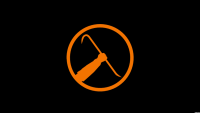Scrollsaw
Summary description of the tool and perhaps some misc notes about it's existence!
| Status | Unknown as of November 2013 |
|---|---|
| Training | Recommended |
| Hackable | NO |
| Usage Restrictions | Members Only |
| Owner | VHS |
| If it Breaks | Unplug machine, put a “broken” sign on machine, contact John. |
| Loan Status | Owned |
| Arrival Date | June 2010 |
| Location | Danger Zone |
| Value | $$ |
| Champion | See Compendium of Champions |
Safe Operation
A scroll saw is an electric saw useful for cutting intricate curves where a jigsaw or coping saw is not appropriate. It is somewhat similar to a band saw, but the bandsaw’s blade is a continuous loop. Scroll saws use saw blades similar to those used by coping saws and operate through a quick reciprocating up and down motion. This is probably one of the safest tools we buy, but still there are a few cautionary steps we should take! To avoid accidents, the following operational safety rules must be observed by everyone working on the VHS Scroll Saw. Failure to follow the safety rules will result in a loss of shop privileges.
Scroll Saw Safety Rules:
- Firmly secure your scroll saw to the tabletop, workbench, cabinet, or floor.
- When making any adjustments, performing maintenance, or changing the blade, make sure the power is off and the cord is unplugged.
- Make sure the blade is the proper type for the cut you are planning.
- Insert the blade with the teeth pointing forward and down towards the table.
- Maintain the proper blade tension.
- Never start the machine before clearing the table or everything but your workpiece.
- Never start the machine until all handles are locked.
- Never reach under the table while the machine is running.
Start with a Risk Assessment to ensure a
safe work area:
- A two foot perimeter around the scroll saw should be kept clear of people, debris that impair traction or footing to avoid slipping.
- Safety glasses with side shields or a face shield must be worn.
- Use the appropriate mask or respirator in dusty work conditions.
- Remove loose fitting clothing, jewelry, and tie back long hair.
- Give the work your undivided attention.
Operational Safety Rules:
- Approach your work at VHS & on the scroll saw with a safe attitude!
- Inspect your stock carefully.
- Support a large workpiece to reduce blade breaking and pinching.
- Always use the hold down device by lowering and adjusting the hold down foot so that it presses lightly on the workpiece, for each new operation.
- Always keep your hands and fingers away from the blade; follow the 3” rule.
- Never place your hands or fingers directly in line with the blade where you could cut them if you slipped.
- Do not start the machine with the blade in contact to the workpiece.
- Hold the work firmly against the table.
- This is a variable speed scroll saw; use the proper speed for the job & type of stock you are cutting.
- Make relief cuts before cutting long or sharp curves.
- STOP the saw and wait until all motion has stopped before removing small scrap & cut off pieces away from blade and off the table.
- Do not cut a workpiece that does not have a flat bottom that can rest on the table.
- Do not cut a workpiece that is too small to safely be supported and held onto.
- Never back out a bound blade from the kerf with the machine on; turn it off, then back out.
- Use a “V” block to cut cylindrical stock.
- When finished, release the blade tension to reduce stress on the blade.
- Clean the table with a bench brush.
